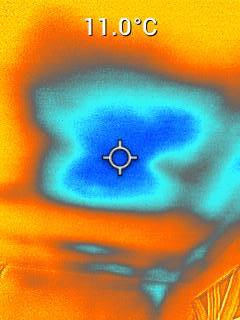Mike's Home Inspector BlogMichael Burfitt |
|
One of the negatives about having relatively mild winters is that we frequently have temperatures around 0 degrees Celsius (or 32 degrees Fahrenheit) and these temperatures can fluctuate between both sides of that number. This can help to form icicles and while as a child it was always fun to break them off, this is a major red flag for home inspectors as no properly constructed home should have them. Icicles are an indicator for one of the main cold weather concerns for home inspector: ice dams. What is an Ice Dam? An ice dam is a problem caused by heat, not cold. It is a ridge of ice that forms at the edge of a roof and prevents melting snow (water) from draining off the roof. Heat escaping from the attic space tends to melt snow, which re-freezes before it is shed from the roof. Contrary to popular belief, sloped residential roofs are generally NOT designed to be waterproof but rather to rapidly and quickly remove water, preferably into a eavestrough and downspout system to be moved away from the home. Snow is a relatively good insulator, so snow will melt close to the roof and remain visible from the outside. Take a look at the picture below for a clearer understanding of how ice dams form. Why is it Such a Concern? You might think: the attic gets a little damp: a well ventilated attic will quickly dry out so what's the problem? The answer is this is simple: water, like nearly everything flows downhill. This means that water will compress and permanently damage attic insulation at first. This will lead to further heat loss through the attic and the formation of even more ice dams and corresponding leaks will increase in frequency. Eventually it will slowly enter the ceiling on the top level (an active leak is rarely obvious at first and before too long can cause major damage to a home). See below an example from a recent inspection where our client was concerned about moisture in the home. The thermal imager shows a very clear anomaly. For my fellow inspectors reading this, you cannot automatically assume this is moisture without further proof: it could just be an area where insulation is missing and this was done on a cold winter's day. My own bathroom shows a similar cold spot but it's from poor insulation in that area not a roof leak. In this case it was obvious from just looking the ceiling was saturated with water and a quick use of a moisture meter confirmed what I already knew. This ceiling will have to be replaced and new drywall installed but the first priority is stopping the leak from happening.
Further investigation shows this particular example was not directly from an ice dam but is the perfect representation of what can easily happen. Remember, moisture is the #1 enemy of homes and an active water leak can seriously damage and even destroy a house! If you are seeing icicles, the first thing you should to is pop that attic hatch, take a look for water infiltration and take appropriate action before water gets into the home. If you have ever seen me in action, you may notice that I tend to spend a relatively long period of time in the attic. There are several things I am looking for including:
While it is not part of a standard home inspection, I also carefully look for any evidence of the presence of pests. There are four major pests I look for that are common in Nova Scotia. Mice & Rats October is a time of leaves falling, Halloween approaching and colder weather coming. This also means that rodents are looking for a nice warm shelter. Unfortunately, mice can squeeze through holes as small as a dime and can produce up to 150 babies a year. Not only do mice carry a significant amount of disease, but they also love to chew electrical wires. Squirrels This is probably the second most common pest I have heard homeowners complain about. Squirrels are acrobatic and will chew through wires to enter an attic space. While disease isn’t as big of a concern, they can quickly wreck electrical systems. Raccoons These pests can tear through vents and mesh and are very intelligent. The biggest danger is that raccoons are very aggressive and will attack humans with their sharp claws. Fortunately, because of their large size it is more challenging for them to enter attics. Birds While I was out for a walk in my neighbourhood, I observed several birds flying in and out of an attic through a hole in the soffit. Birds not only carry diseases but tend to get very comfortable if not removed immediately. While they won’t chew like squirrels, they have the advantage of being able to fly to any hole to enter the attic space. What can you do to keep these residents from squatting in your home? There are a few common steps to take to be proactive. Remember, the best way to remove pests is to prevent them from entering in the first place.
While it can be very difficult to detect many of these pests, I am always on the lookout for evidence such as droppings, unusual insulation patterns and potential entry points. I hope to never have to encounter a pest in the attic and hope you never have to deal with the headache of removing them. |
Archives
July 2024
Categories
All
|
|
Inside Edge Home Inspections Ltd.
Halifax, NS 902-209-9921 [email protected] Proudly Serving the HRM & Central Nova Scotia |





 RSS Feed
RSS Feed

